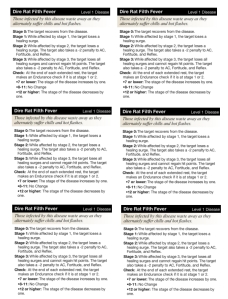Yesterday, I shared my overall impressions of Heroes of the Feywild. Today, I’m reviewing the races and classes. Tomorrow I’ll wrap up with character options and the alternative background rules.
Races
We get three new races here: Pixies, satyrs and hamadryads. All of them have optional racial utility powers that you can take instead of a class utility power at levels 2, 6, 10, 16 and 22 which I find to be very cool. WotC apparently started doing this with Heroes of Shadow, and I never really noticed. Oops.
The pixie
The pixie is polarizing, to be sure. Personally, I’m fine with it as a semi-comic-relief character. I’d have a hard time taking a pixie character seriously, but maybe one of my players will prove that a pixie can make you cry.
The fact that the pixie is Tiny and can shrink things down to its size gives it the most potential for weirdness. You know, like building a pixie berserker whose schtick is charging into enemies’ spaces. I’ve heard the idea of a pixie shrinking something like watermelons and feeding them to an enemy, only to have them expand after the pixie’s next extended rest. I’m sure there are lots of non-combat uses for the Shrink power, making an object easy to hide for a while, and I’m on board with that.
I’ll note that the origin story of the pixie makes it clear that the Summer Queen is evidently the most popular girl in the feywild. Four different guys thought they might be the pixie’s father? The Queen gets around.
Finally, I’ll note that if you’re looking for a less frou-frou take on the pixie, listen to episode 2 of Dice Monkey Radio, where Mark Meredith and I (mostly Mark) talk about using the pixie chassis to create a pseudo-dragon race. Pixie dust? Boring. Flame jet? Okay!
Satyr
The satyr isn’t especially exciting to me. The racial utility power of sliding an enemy 3 squares after hitting it seems a little dull. The more relevant ability may be Pleasant Recovery: every healing surge the satyr spends while resting gives him an extra 1d8 hit points. I also love the level 2 Satyr’s Leap utility power that lets the satyr jump all over the board – an at-will move action that gives the satyr a running jump with a +10 bonus to the athletics check. Boing! Difficult terrain should be no problem.
Hamadryad
The poor hamadryad is even less exciting to me than the satyr. A lady who can turn into a tree… nope, doesn’t do it for me. The Hamadryad Aspects racial utility is actually pretty good – you get your choice of a turn’s worth of combat advantage against everyone who can see you, or damage resistance. She also has a racial bonus to saving throws against daze, dominate and stun effects – the kind you really want to save against. But flavor-wise, I’m just not feeling it. I didn’t have any love for the Wilden, either; perhaps I’m just anti-plant when it comes to PCs.
Classes
Good stuff here. We get the berserker barbarian, the skald bard, the protector druid and the witch wizard. All of the classes follow the standard 4e at-will / encounter / daily / utility (AEDU) structure, though some are built to do well with basic attacks, too. They’re allowed to choose powers from the earlier builds of their respective classes, and the new powers introduced in Heroes of the Feywild are also available for the earlier builds to take (though in several cases the earlier builds can’t really make good use of the new powers).
Berserker
Yes, I’ve already written about Crazy Wings, the pixie berserker. Not every berserker has to be so gimmicky.
The berserker is the first role-switching class WotC has produced. It starts off combat as a defender, with the same Defender Aura that the knight and similar classes have gotten, plus a good punishment mechanic in Vengeful Guardian (shifting or attacking a non-defender brings a melee basic attack with a d8 of bonus damage from the berserker). The aura also gives the berserker a +2 AC bonus.
However, once the berserker uses a primal attack power (not just a daily rage – primal encounter powers and even primal at-will primal powers from other books count here), the aura goes away and the berserker becomes a striker. In this mode, the berserker deals an extra d8 of damage on melee basic attacks, and the at-will powers in this book get extra damage as well. The berserker also has the option of switching into striker mode as a minor action if the character is bloodied. The berserk effect lasts until the end of the encounter, so there’s no way to switch back to being a defender once the berserker goes into striker mode.
The berserker also gets to choose from three homelands, which provide different benefits. Desert berserkers get +3 AC and +2 Reflex if they wear cloth armor and carry no shield, plus some fire resistance at later levels. Frozen land berserkers get +1 to Fortitude and Will, plus some cold resistance at later levels. Temperate land berserkers get +2 to damage rolls if they use a one-handed weapon and a shield. Aww yeah! They also get a speed bonus while charging at 4th level. I like the temperate land, personally.
I’ll note that the Stalk and Strike at-will power seems very good in that it lets the berserker shift 2 squares before the attack. Good stuff.
I’ve never played a barbarian before, but I could definitely see myself wanting to roll up a berserker. The role-switching brings a cool new aspect to decision-making at the table. I worry that it might slow the game down a little as the berserker’s player agonizes over when to go berserk, but experienced players should be able to handle this.
Skald
First, I’ll mention that I’d never heard of a skald before. It’s apparently a reference to viking bards, basically, though they’re not flavored in a viking way in this book. These are the folks who recite saga poems.
Next, I’ll say that I LOVE the skald. Regular readers know of how much I love my bard Factotum for Living Forgotten Realms games, and I wish I could make him into a skald. More on that later.
Right off the bat, the skald gets some flavorful non-combat abilities – groupies, favor with the king, a sweet ride, etc. I love this stuff.
The skald gets the Deceptive Duelist class feature, which lets him use Charisma instead of Strength for melee basic attacks with one-handed weapons. Huzzah!
Instead of Majestic Word, the skald gets Skald’s Aura, which is a cool twist on healing. It costs a minor action to turn it on during the encounter, and once it’s on any ally within 5 squares (or the skald himself) can spend a minor action to spend a surge and gain bonus hit points (1d6, 2d6, 3d6, etc. as the skald levels up). These folks also have the option of using a minor action to use the healing power on an adjacent ally instead. How cool is that? The skald himself doesn’t have to bother using the healing; whoever needs it can help themselves. The twice-per-encounter (three times at level 16+) limit still exists, but I personally think it’s awesome. Getting the d6 instead of the bard’s Charisma bonus is going to be a loss for most bards, as is giving up the free square of sliding, but that’s okay. I like the aura.
The skald still gets Song of Rest and Words of Friendship, and he also gets a spellbook-like ability to choose two daily powers at first level and decide each day which one to have available. He doesn’t get to pick two powers at 5th level or anything like that, though. It’s a little odd.
The bard’s at-will attack powers are all minor actions that work like stances (they stay on until the end of the encounter). They all have the effect along the lines of, “Each time you hit an enemy with a basic attack, one of your allies in the aura gains…” some bonus (temporary hit points, extra damage on their next attack, a bonus to their next attack roll, a bonus to defenses). The daily powers are similar in that they apply some beneficial effect to all allies in the skald’s aura. The encounter powers are all No Actions that trigger when the skald hits an enemy with a basic attack – kind of like Power Strike.
So, the skald straddles the AEDU structure and the “martial Essentials character” structure a little bit, which is fine with me. I’d love to rebuild Factotum as a skald, but unfortunately there’s only a feat to let regular bards get the skald’s aura, not the Deceptive Duelist power that lets the skald rely on Charisma for basic attacks. My problem is that Factotum has to have the original bard’s unlimited multiclassing, and skalds don’t get that. I wish I could give up Master of Story and Song and even Skill Versatility or Words of Friendship in order to be allowed unlimited skald multiclassing, but alas that would have to be a house rule.
I’ll also note that the skald’s powers at higher levels are explicitly improved versions of his powers at lower levels, with tweaked names. Lesser Dimensional Step at level 1 can be replaced with Dimensional Step at level 13 and Greater Dimensional Step at 27. You don’t HAVE to make those choices, but you can. This goes for all of the skald’s encounter powers. Again, it’s somewhat straddling the AEDU and “martial Essentials” structures, which is fine with me.
Protector
The protector druid, like the original PHB2 druid, is a controller. Unlike the PHB2 druid, the protector doesn’t turn into an animal. Instead, it has an encounter power that lets it create a zone of difficult terrain, and other powers can interact with this zone. The protector’s main schtick is summoning monsters to fight for the druid, ranging from Giant Cobras and Grizzly Bears at level 1 to Bulettes and Hunting Tigers at level 15 and ultimately Blue Dragon Wyrmlings and Raptor Behemoths at level 29.
Summon Natural Ally is the protector’s daily power, and at higher level the protector gets to use it more often (rather than getting new dailies). If you like summoning monsters to fight for you, well, try out the protector.
I’ll also note that the protector gets three “Primal Attunement” powers, which are basically druid-flavored cantrips. I love minor magical effects, so I’m a fan of Primal Attunement.
Witch
The witch is a sub-class of the wizard (it seems like every new magic class is a sub-class of the wizard these days!). Comparing the witch to the arcanist (the original PHB1 wizard), the witch gives up Arcane Implement Mastery, Ritual Casting and the spellbook, and in exchange gets a familiar, a moon coven, and the Augury power.
The witch’s familiar works like a regular familiar (the rules for which are reprinted in this book – yay!), but with two extra benefits. First, the witch’s familiar has a spellbook-like ability to let the wizard switch a daily attack power or a utility power for a different one. Second, at level 24 the familiar lets the witch spend an action point to recover an expended encounter power, getting combat advantage for that power.
The witch gets three cantrips, but only one (Chameleon’s Mask) is actually listed in this book, so you HAVE to have another book (or, you know, a DDI subscription) if you want to build a witch. That doesn’t bother me, but I was still surprised to see it.
Augury is a power that will definitely depend on your DM. Some DMs might give you a lot of info from Augury while others will not.
The moon coven determines whether you’re a good witch or a bad witch (I’m not a witch at all). Dark Moon (aka New Moon) gives you Dread Presence (a necrotic-themed power) while Full Moon gives you Glorious Presence (a power with some healing). These are the witch’s level 1 encounter powers, but these powers are available for any wizard to use, which I appreciate.
The new wizard powers introduced in this book are often witchy-themed, which I find fun. The Beast Switch at-will has the flavor of the witch briefly turning the target into a frog. Witch Bolt is an at-will with a sustain standard – I don’t think I’ve seen that before! Simple Animation is a level 2 utility power that lets the witch go all Sorcerer’s Apprentice by animating an object (such as a bucket-carrying broom). Foe to Frog is a level 5 daily that actually does make the target into a frog (the return of Slimy Transmutation!).
I can’t really evaluate the power level of these options, but it does seem like there are some fun new spells here for the wizard, and none of them appear to rely on being a witch. More love for wizards from Wizards.
More to come
Tune in tomorrow for the exciting conclusion of my take on Heroes of the Feywild!
-Michael the OnlineDM
OnlineDM1 on Twitter








